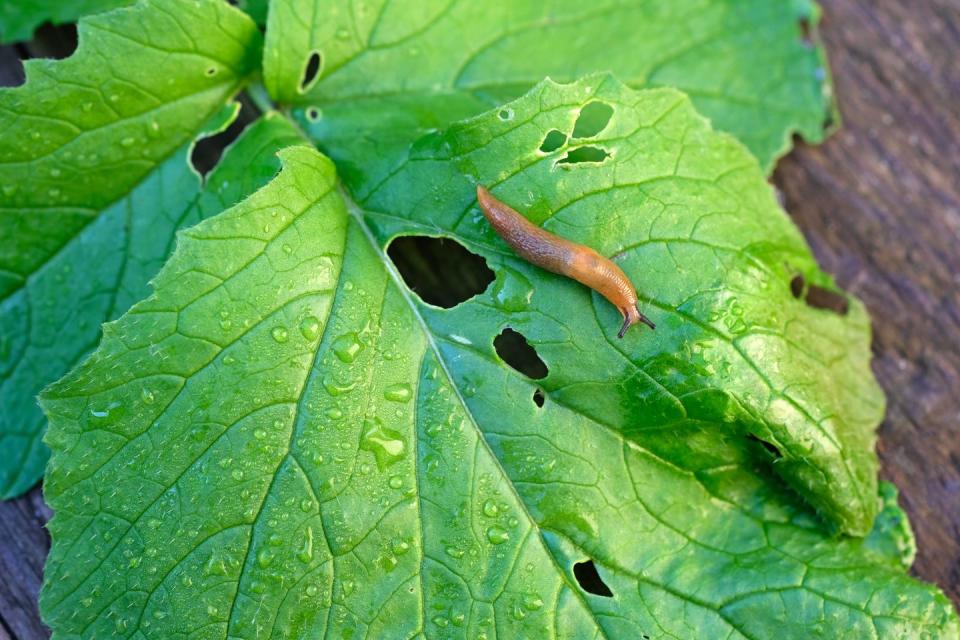12 plants slugs won't eat

Slugs and snails have long been viewed as a gardener's greatest foe. Many would argue that they're one of the biggest garden pests, especially during springtime when colourful flowers start to bloom, bringing the garden to life after a dreary winter.
While there are some preventative methods and a few traditional barriers you can try to get rid of slugs in the garden (crushed eggshells don't work but strong-scented plants do), it turns out learning to co-exist with these slimy creatures is the most effective solution, alongside growing the right plants.
In truth, slugs and snails actually contribute positively to a garden's ecosystem. Referred to as 'nature's clean-up crew', molluscs feed on rotting plants, fungi, dung and even carrion, helping to recycle nitrogen and other nutrients and minerals back into the soil. They can also clean algae off a greenhouse glass, leaving behind their trademark trails.
Some much-loved garden visitors – including frogs, song thrushes and ground beetles – also rely on slugs and snails as a key food source, and they make up part of a hedgehog's diet, say the RHS and The Wildlife Trusts, who have joined forces to challenge the negative perception surrounding slugs and snails in gardens with the Making Friends with Molluscs campaign.
Slug-friendly control: how to stop slugs eating plants
'Slugs and snails love damp, warmer weather so it’s best to take precautions now,' says Chris Bonnett, founder of Gardening Express. Follow these expert tips to keep slugs off plants while welcoming these molluscs into your garden.

1) Grow plants indoors
As far as preventative measures go, where possible you should grow seedlings indoors for as long as possible before planting them out. Remember, young, tender plants are often the tastiest for slugs and snails. After transplanting, cover your plants with a cloche. If you have the space, protect your most vulnerable produce in a glasshouse. Fruits are also less likely to be damaged by slugs and snails when grown in pots or hanging baskets, but if you've planted strawberries in the ground, for example, place straw around it to deter slugs.
2) Choose plants that slugs won't eat
So what's the best way to keep slugs off plants? The best approach is to plant the right plant in the right place. Put simply, if you know you have a slug and snail-prone garden, it's best not to grow plants that are susceptible to slug damage, the RHS and The Wildlife Trusts advise.

This is where selective planting comes in. Choose plants that are less attractive to slugs and snails or are more resilient to their feeding habits. For example, slugs are less keen on woody hydrangeas and strong-smelling plants like onions and herbs. Some RHS-recommended plants that are less likely to be eaten by slugs are...
Agapanthus hybrids and cultivars
Antirrhinum majus (snapdragon)
Tropaeolum species (nasturtium)
Geranium species
Foeniculum vulgare (fennel)
Japanese anemone
Astrantia major
Digitalis purpurea (foxglove)
Eryngium species
Fuchsia cultivars
Dicentra spectabilis (bleeding heart)
Rudbeckia fulgida
FYI: Slugs love sweet peas, tulips, hostas and dahlias, so avoid planting excessive amounts of these.
3) Plant more crops
You may also choose to plant additional crops for slugs to enjoy. 'In vegan gardening, it is always wise to plant a surplus so that it doesn’t matter if some of your plants are lost to animals or insects,' says Shannen Godwin, growing expert at bulb company J. Parker's. 'You can do this by planting extra quantities of the plants you want or adding companion plants that you grow specifically for the wildlife to enjoy. Marigolds and petunias are fantastic companion plants for crops as these will divert slugs away from what you’re trying to grow.'
4) Experiment with traditional slug barriers
Harmless barriers, such as copper tape and wool pellets, may provide some protection for vulnerable plants from slug and snail damage.
Interestingly, in a RHS study, Hayley Jones, principal entomologist and lead researcher, tested a number of traditional slug barriers (crushed eggshells, pine bark mulch, copper tape, sharp horticultural grit and wool pellets) around lettuce plants, and found that none of them were effective by the end of the six-week test period.
'I've not given up on barriers yet, copper has worked in some studies and wool pellets may have a short-term effect,' says Hayley. 'But eggshells aren't worth it, slugs and snails can make extra thick mucus to traverse anything sharp, and the source of calcium may actually be attractive to them!'
In April 2022, the sale and use of slug pellets (which contained metaldehyde) was banned in the UK as it posed an 'unacceptable risk' to wildlife.

5) Handpick and monitor
If you're not doing so already, get into the habit of regularly inspecting plants for signs of slug and snail damage, and manually remove any you find. Relocate them to your compost heap or areas with less vulnerable plants. It's worth doing this in the evening, as slugs and snails are most active at nighttime.
Many slug and snail species do not feed on live plants but are detritivores, consuming dead plant material, fungi and dead animals. They break down plant and leaf litter, returning nitrogen, nutrients, and minerals to the soil.

6) Provide shelter
If you create a habitat for slugs and snails, it may make them less likely to venture out into your vegetable bed. Leave log piles, mulch and natural debris in your garden for shelter and a food source.
7) Don't forget to encourage predators too
Create a haven for natural predators of slugs and snails – including ground beetles, song thrushes, frogs and toads – by providing suitable habitats. This could include long grass, log piles and wildlife-friendly ponds. Remember, predators help to naturally regulate slug and snail populations, and in turn, keep their numbers in balance.
Follow House Beautiful on TikTok and Instagram.
You Might Also Like



